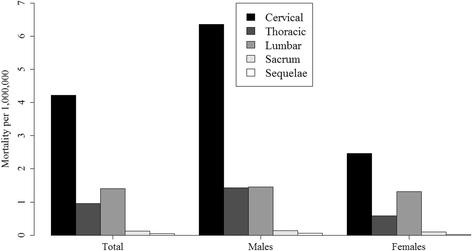Mortality due to traumatic spinal cord injuries in Europe: a cross-sectional and pooled analysis of population-wide data from 22 countries
- PMID: 28673315
- PMCID: PMC5496373
- DOI: 10.1186/s13049-017-0410-0
Mortality due to traumatic spinal cord injuries in Europe: a cross-sectional and pooled analysis of population-wide data from 22 countries
Abstract
Background: Traumatic spinal cord injuries (TSCI) pose a significant burden globally, while existing epidemiological data-especially on population mortality-are limited. The aim of this study was to calculate the age-standardized population mortality rates attributable to TSCI in 22 European countries, along with the pooled age-standardized mortality rate attributable to TSCI in Europe.
Methods: A descriptive cross-sectional epidemiological study was conducted. Crude and age-standardized mortality rates attributable to TSCI for the year 2012 for 22 European countries were compared using data from death certificates provided by Eurostat. Pooled age-standardized mortality rates were calculated using the random effects model, and overall number of cases were estimated by extrapolating our findings to the populations of EU and Europe (48 countries), in 2012.
Results: A total of 1840 TSCI-related deaths were identified, of which 1084 (59%) were males. The pooled age-standardized TSCI-related mortality rate of 6.7 per million (95% CI: 5.2 to 8.2) overall, 9.4 (95% CI: 7.3 to 11.5) for males, and 4.5 (95% CI: 3.4 to 5.6) for females. Extrapolating our results, 3152 (95% CI: 2441 to 3915) deaths would occur in 2012 in the EU-28 and 4570 (95% CI: 3538 to 5675) deaths in the whole Europe. TSCI-related deaths contributed by 2% (95% CI: 1.8% to 2.2%) to the overall injury related mortality. 61% of fatal TSCI were located in the cervical spine area.
Conclusion: To our knowledge, this is the largest study that reports TSCI-related population-based mortalities to date which brings valuable information that can inform further research or prevention strategies. Our study presents a comprehensive and large-scale overview of TSCI-related population mortality in Europe. With an estimated toll of nearly five thousand lives that could be potentially saved by prevention, our findings confirm TSCI as an important cause of injury related deaths in Europe. Further action towards harmonization of case ascertainment and towards prevention strategies targeted mainly on the elderly is warranted.
Keywords: Age-standardized mortality; Cross-sectional analysis; Death certificates; Epidemiology; Europe; Eurostat; Mortality; Outcome; Prevention; Traumatic spinal cord injury.
Conflict of interest statement
Authors’ information
Not applicable.
Ethics approval and consent to participate
The study used administratively collected secondary data and no ethics committee approval was required.
Consent for publication
Not applicable.
Competing interests
The authors declare that they have no competing interests.
Publisher’s Note
Springer Nature remains neutral with regard to jurisdictional claims in published maps and institutional affiliations.
Figures





References
-
- WHO. In: Bickenbach J, Bodine C, Brown D, Burns A, Campbell R, Cardenas D, Charlifue S, Chen Y, Gray D, Li L, et al., editors. International perspectives on spinal cord injury. Geneva, WHO; 2013.
MeSH terms
LinkOut - more resources
Full Text Sources
Other Literature Sources
Medical

